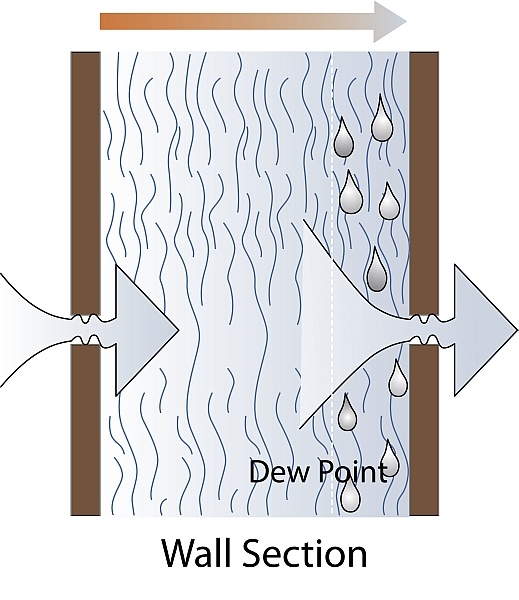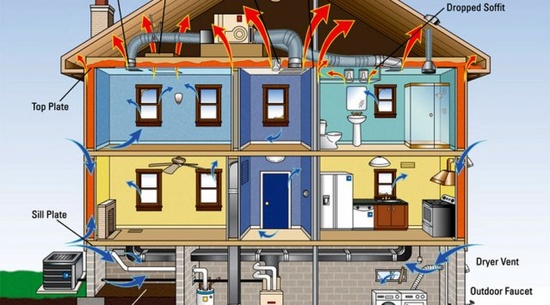The Difference between Vapour and Air Barriers
by Mark Row
 Find a Solution for every Problem
Find a Solution for every Problem
Probably the most common problems nowadays in both older and modern building constructions are moisture and condensation problems. These can significantly influence the building structure and stability, its durability, the ability to withstand unpredictable weather conditions and what’s most important of all, the quality of life since it can also affect your health and the overall thermal performance of your home. Now, there are a few ways people are trying to deal with such problems that is to prevent the moisture and air to travel through walls, ceilings and floors. Probably the most common means of defence are the so called vapour and air barriers. If you are thinking of dealing with the problem yourself you will have to know the difference between vapour and air barriers, which we will try to explain further on.
A Few Basic Facts on Both
Namely, vapour diffusion is a process where moisture and vapour finds its way through building materials, such as insulation or drywall. Simply put, at the so called dew point, the condensation and vapour will turn into water. The dew point level depends on the relative humidity of air that is the amount of moisture and the difference between the inner and outer temperature. The greater the both parameters the faster the dew point is reached. Now, the basic function of a vapour barrier is to prevent the moisture from travelling through the building components of the wall. It is important to know that all materials have a certain resistance to moisture diffusion, some better than the others, meaning that the barrier you opt for will depend on specific conditions, since in some ways thicker concrete, glass, metal or even special paints and aluminum foils may do the trick, while in others some specially designed materials are more suitable, like polyethylene films. Regardless of the material you opt for, it should always be placed on the warm side of the insulation, while avoiding any unsealed laps and holes.

Another way for water vapour to travel through the building envelope is air leakage which occurs when cracks or holes in the building material create a continuous path from the outside to the inside with the present difference in air pressure. Those cracks and holes can be caused by a numerous of reasons like the cracks between structural elements appearing over time, poor connection between the wall and the roof, block and brick movement etc. The difference in air pressure can occur from one (or more) of three factors including the stack effect (caused by temperature differences), wind forces and the ventilation equipment. Well, the air barrier is there to prevent the above explained from happening, that is to stop the outside air from getting in and the inside air from travelling out the building, regardless of the level of air humidity since air leakage unlike vapour diffusion can cause even more problems like cooling and heating energy reduction or even pollution brought in through the air leakage path. For the barrier to serve its purpose, it must be well connected meaning that it must run continuously through the wall and the roof (or the window frame); the entire system must be rigid enough and properly fastened to the structure; it must air-impermeable (as much as possible). Finally, it must be durable enough so it can follow the lifespan of the building itself.

Vapour-Air Barrier Relation
As previously explained, the basic difference between vapour and air barriers can be found in their purpose – while one is used to stop (or reduce) vapour diffusion, the other is there to prevent air leakage. Besides this basic difference, it is worth to mention that while vapour barrier is usually only one, air barrier can be used in many forms and in different areas and spaces. It is very important to know that though these two can be combined since the use of one does not necessarily exclude the need for the other. For example while water barriers can also be used to stop air leakage that is not the case with the other way around, meaning that air barriers will not always stop the vapour movement. It will always depend on the specific materials, since some can work both as air and vapour barriers, while others won’t. The previously said is important due to the applicable regulation and the prescribed values, since sometimes the use of only one material is enough, while in other cases materials need to be properly combined.
Finally, unlike vapour barriers that are very talked about, with an already built and developed system, that is not the case with the other type of barriers, which can, believe it or not prove to be much more useful, since usually the greatest amount of moisture is actually transferred through the air. But until a definite conclusion is reached, these two should be combined in order of achieving the best possible results.
Feel free to leave your opinion on vapour and air barriers in the comment section. Hit the like button if you found the above written information useful.




















































































































